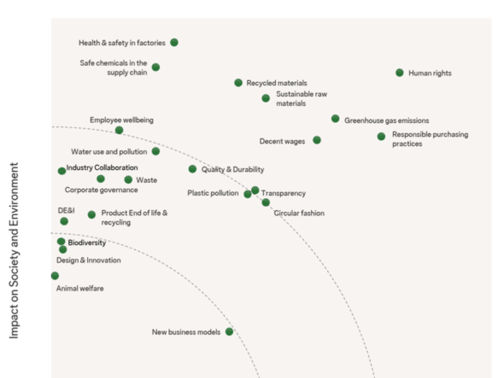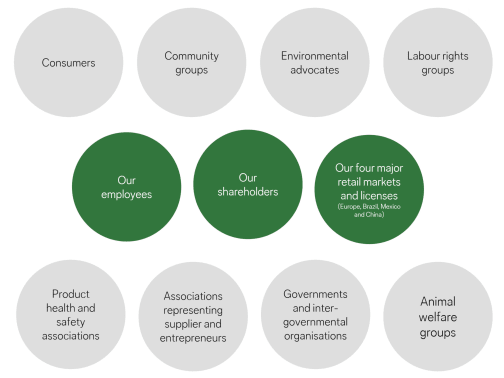How we manage sustainability
Global Sustainability Governance
The C&A AG has a well-organised and streamlined business planning and decision-making process that integrates and embeds sustainability. The C&A Global Sustainability team works closely with other functions across the business and collaborates with C&A retail market teams to help develop locally relevant plans and key performance indicators that advance us towards our 2028 sustainability goals at the C&A brand level, whilst recognizing ownership of locally relevant plans by the retail market teams. Each retail market business and the C&A AG Sustainability Committee review and approve these action plans bi-annually.
C&A Europe Sustainability Governance
At C&A Europe, we apply clear accountabilities and governance process to plan and execute the sustainability strategy. The C&A Europe Range & Sustainability (R&S) Committee — which includes the CEO, members of the Leadership Team, Head of Transformation Office, and selected Heads of Functions when relevant — reviews and approves targets, goals and roadmaps and meets monthly.
The C&A Europe Sustainability Council provides further support to the R&S Committee and helps to define and drive execution of our sustainability goals. The Council represents all the business units that have sustainability targets associated with their performance and provides a forum to align on actions and prioritization. The Council meets quarterly to ensure the implementation of the Sustainability goals is on track versus the roadmaps approved by the R&S Committee. The Council includes Heads of Function for all areas directly involved in the sustainability strategy execution, as well as the Transformation Office.
The Global Sustainability Team, led by the Head of Global Sustainability & Innovation has strategic as well as operational responsibilities. Dedicated leads for Social, Environmental, Raw Materials & Circularity and Transparency & Reporting propose strategic initiatives and collaborate with the business to drive execution and identify critical concerns. The leads report to the Head of Sustainability or the Head of Sourcing who report to the Chief Operations Officer. The Chief Operations Officer is part of the C&A Europe Range & Sustainability Committee.
At C&A Europe, Sustainability Governance is as follows:
Range & Sustainability Committee responsibilities | Sustainability Council Responsibilities | |
|---|---|---|
1. | Review and sign off on roadmaps for goals and target implementation | Drive execution towards goals implementation |
2. | Provide guidance and empowerment to the Sustainability Council | Develop sustainability action proposals for approval by the R&S Committee |
3. | Allocate resources as needed | Share topics of interest, and suggest priorities for action with the R&S Council |
4. | Assess risk and manage dependencies | Support sustainability programmes, provide context, input, and expertise |
5. | Provide forward thinking and strive for “what’s next“ in the agenda | Review reports both to R&S Committee and the C&A AG Sustainability Committee |
6. | Meet monthly | Meet quarterly |
Linking Executive Compensation to Sustainability Performance
Globally, the members of C&A leadership are evaluated quarterly against their defined business goals, of which sustainability performance is a part. Among our leadership, the Head of Global Sustainability & Innovation together with the Chief Operations Officer have the most significant responsibility for ensuring our sustainability strategy is implemented by all the business units and meeting our key performance indicators for human rights, environmental management, and other aspects of our sustainability strategy, with bonus compensation directly tied to successful achievement of these goals. Sustainability objectives are also included in the annual bonus compensation of C&A retail market leadership.

